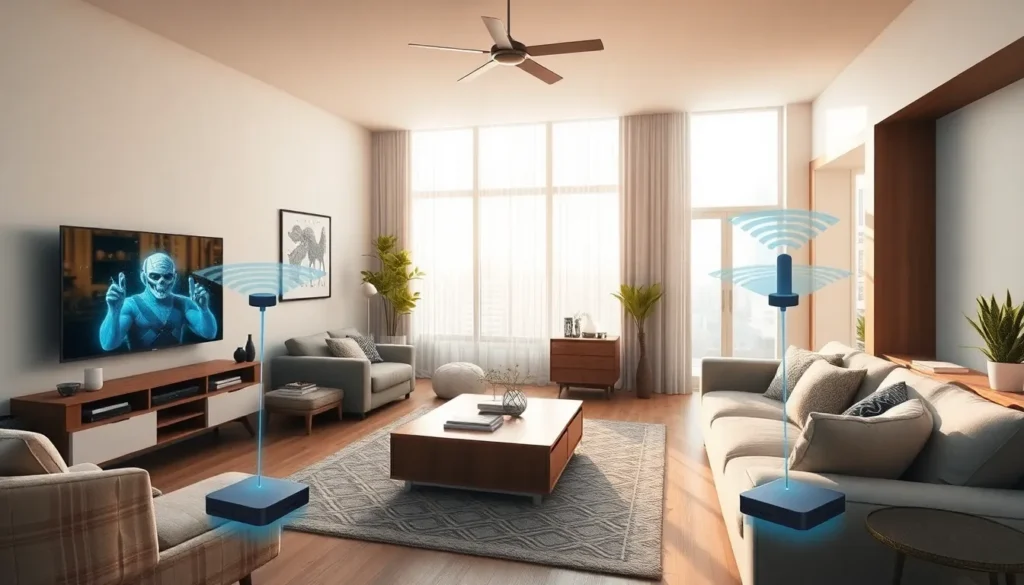Table of Contents
ToggleIn today’s world, a reliable internet connection isn’t just a luxury; it’s a necessity. Picture this: you’re in the middle of an epic online game or binge-watching your favorite show, and suddenly, the dreaded buffering wheel appears. Enter the age-old debate: mesh WiFi versus extenders. Both promise to rescue you from the clutches of dead zones, but which one really delivers?
Mesh WiFi systems offer seamless coverage throughout your home, eliminating those pesky dead spots like a superhero swooping in to save the day. On the other hand, WiFi extenders can be a bit like that friend who always shows up late to the party—helpful but not quite what you hoped for. Join the discussion as we dive into the pros and cons of each option and help you decide which one’s right for your internet needs.
Overview of Mesh WiFi and Extenders
Mesh WiFi systems consist of multiple interconnected devices working together to provide a robust signal across larger areas. Each device, or node, connects wirelessly, ensuring a consistent and strong signal throughout homes or offices. This configuration effectively eliminates dead zones, providing better coverage and seamless connectivity.
In contrast, WiFi extenders amplify existing WiFi signals to reach areas lacking coverage. While they boost the signal, they can reduce overall speed and may suffer from connectivity issues. Extenders connect to the main router, creating a separate network often identified by a different series of numbers.
Quality differences between the two options are notable. Mesh systems offer unified networks, allowing for consistent speed and reliability across all devices. Extenders may result in variable performance, especially in larger spaces where obstacles weaken signals.
Cost is another factor to consider. Mesh WiFi systems typically have a higher upfront cost but provide enhanced coverage and performance. WiFi extenders generally have a lower initial price but may require replacements over time due to performance limitations.
Installation processes differ as well. Mesh systems often feature user-friendly interfaces for easy setup. Extenders may require manual configuration, which can be more technical for some users.
Either option presents distinct advantages and disadvantages. Mesh WiFi suits larger spaces with numerous devices, while extenders benefit smaller areas needing quick solutions. Choosing the right system depends on specific needs and the layout of the space involved.
Key Differences Between Mesh WiFi and Extenders

Understanding the differences between mesh WiFi systems and extenders helps in making a well-informed choice. Each solution has its strengths and weaknesses.
Coverage and Range
Mesh WiFi systems offer extensive coverage due to multiple devices working together. Coverage can extend to over 5,000 square feet when several nodes are deployed. In contrast, extenders typically cover smaller areas, often limited to about 2,000 square feet, depending on their model. Users experience consistent signal strength throughout a mesh network, eliminating dead zones efficiently. On the other hand, extenders may encounter signal degradation as they amplify existing networks. Installation of mesh systems creates a unified network, whereas extenders generate separate networks, often complicating connectivity. Overall, mesh setups excel in larger spaces needing seamless coverage, while extenders provide a quick fix in smaller areas.
Performance and Speed
Performance varies significantly between the two options. Mesh WiFi systems maintain high-speed connections across various devices, commonly offering gigabit speeds. They provide a stable connection for activities demanding bandwidth, such as streaming or gaming. Extenders, however, may reduce speed by up to 50% when rebroadcasting existing signals. Users often face latency issues with extenders as devices switch between networks. In real-world applications, mesh systems prove advantageous for households with multiple online activities occurring simultaneously. Conversely, extenders can occasionally serve well in limited use cases, making them suitable for casual browsing. Thus, speed and performance tilt in favor of mesh networks, particularly for users needing optimal service.
Advantages of Mesh WiFi
Mesh WiFi systems come with several advantages that enhance internet connectivity for users in larger spaces.
Scalability
Scalability represents a significant advantage of mesh WiFi systems. Users can easily expand coverage by adding more nodes without compromising performance. Each additional node seamlessly integrates into the existing network, maintaining consistent connectivity throughout the area. This flexibility allows users to accommodate changing needs, such as new rooms or outdoor spaces. In contrast, traditional WiFi extenders often require separate setups, which can complicate network management. Mesh systems effectively adapt to users’ growing demands, offering an optimal solution for households with multiple devices.
Seamless Connectivity
Seamless connectivity is another key benefit of mesh WiFi. Unlike extenders that create isolated networks, mesh systems provide a unified network experience. Users can roam freely throughout their homes without experiencing disruptions in their internet connection. Devices seamlessly switch between nodes as users move from room to room, ensuring strong signals and low latency at all times. Overall, mesh WiFi systems deliver a consistent user experience, making them especially suited for activities like online gaming, streaming, and video conferencing.
Benefits of WiFi Extenders
WiFi extenders present various advantages for enhancing internet coverage in homes and offices. These devices empower users to boost signal strength where connectivity lags, reducing dead zones.
Cost-Effectiveness
Cost-effectiveness stands out as a primary advantage of WiFi extenders. Compared to mesh WiFi systems, extenders usually come at a lower price point, making them accessible for budget-conscious individuals. Many households find extenders suitable, particularly in smaller spaces where extensive coverage isn’t necessary. Users can often achieve improved connectivity with a single extender instead of investing in a full mesh system, which may include multiple devices. For a modest cost, extending the WiFi range ensures a better experience for streaming and browsing.
Easy Installation
Easy installation contributes significantly to the appeal of WiFi extenders. Most devices feature plug-and-play designs, allowing users to set them up quickly without technical expertise. Users can typically connect the extender to the existing network using a straightforward process, often guided by mobile apps or simple manuals. This convenience means households need minimal disruption when enhancing their WiFi coverage. As a result, anyone seeking immediate improvement in signal strength can benefit without facing complicated installation hurdles.
Conclusion
Choosing between mesh WiFi systems and extenders ultimately depends on individual needs and home layouts. For those seeking comprehensive coverage and seamless connectivity in larger spaces mesh systems emerge as the superior choice. They provide consistent speed and flexibility that can adapt to evolving requirements.
Conversely for smaller areas or budget-conscious users WiFi extenders offer a practical solution. They’re easy to install and can quickly enhance connectivity without a significant investment. Evaluating the specific demands of a household will guide users toward the most effective option for achieving reliable internet access throughout their space.







